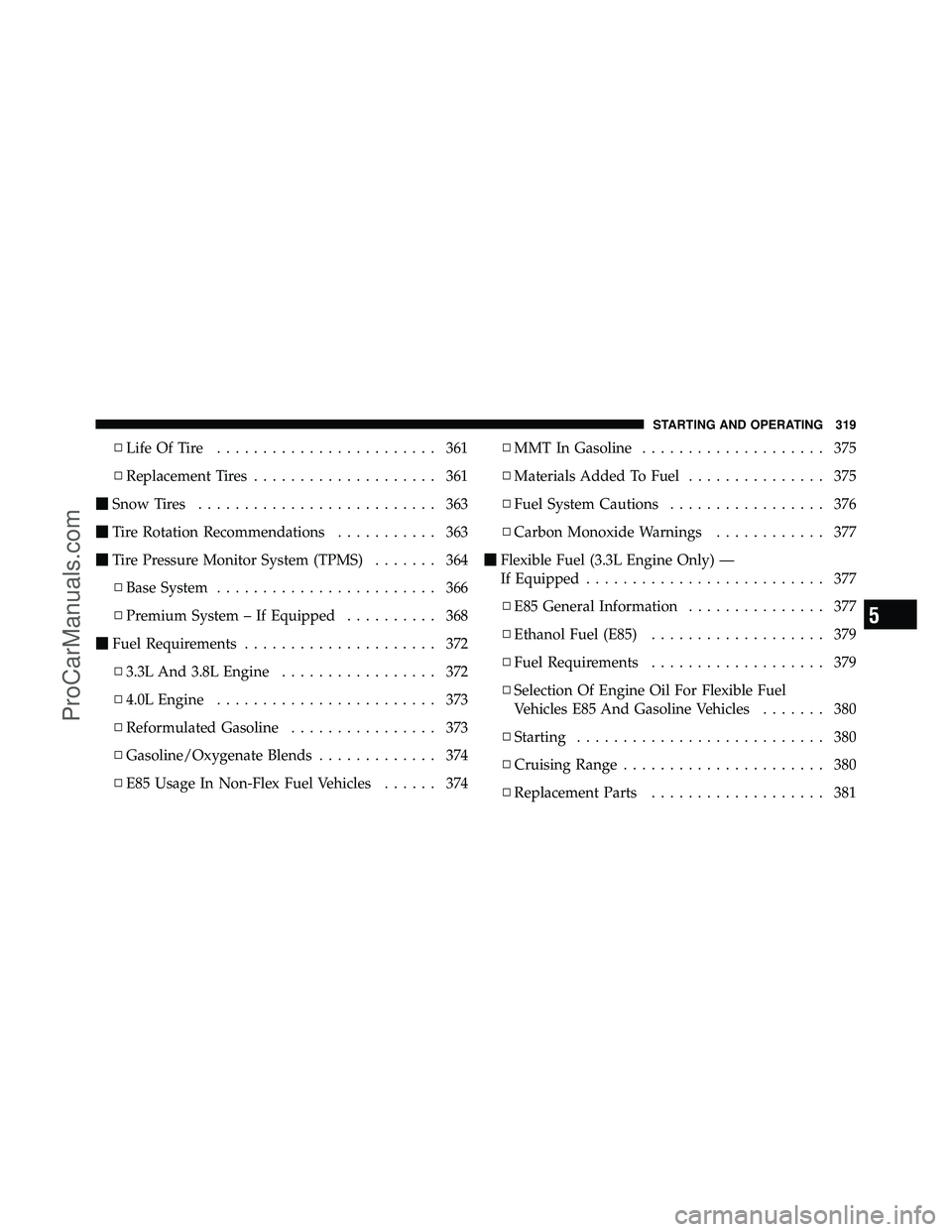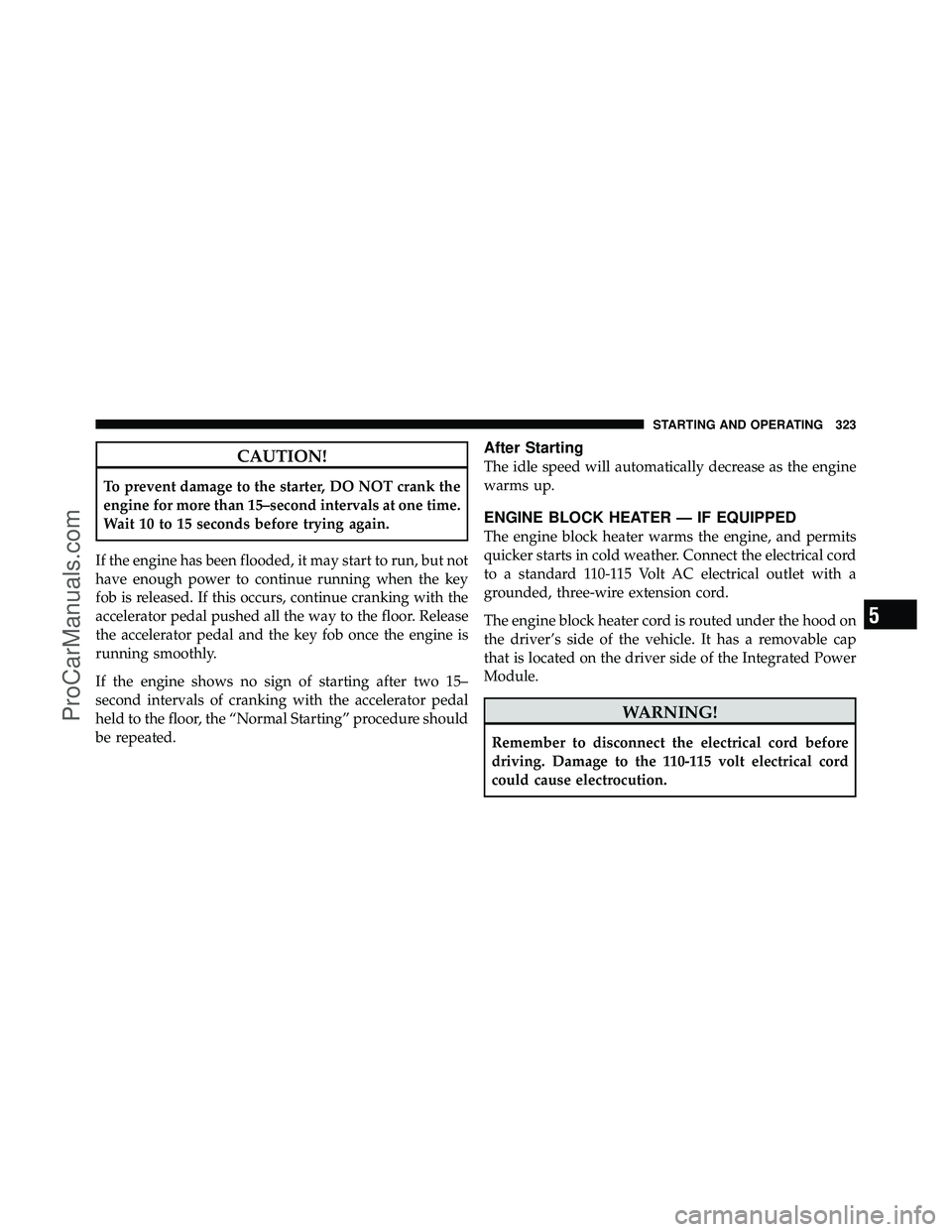Page 309 of 530

Automatic Operation
1. Press the AUTO button on the Front Upper ATC Panel
and the word AUTO will illuminate in the front ATC
display, along with three temperatures for driver, front
passenger, and rear seats. The system will then automati-
cally regulate the amount of airflow.
2. Next, adjust the temperature you would like the
system to maintain, by adjusting the driver, front passen-
ger, and rear seat rotary temperature knobs. Once the
desired temperature is displayed, the system will achieve
and automatically maintain that comfort level.
3. When the system is set up for your comfort level, it is
not necessary to change the settings. You will experience
the greatest efficiency by simply allowing the system to
function automatically.NOTE:•It is not necessary to move the temperature settings for
cold or hot vehicles. The system automatically adjusts
the temperature, mode and fan speed to provide
comfort as quickly as possible.
•The temperature can be displayed in English or Metric
units by selecting the “Display Units of Measure in”
customer-programmable feature. Refer to the “Elec-
tronic Vehicle Information Center (EVIC) — Customer-
Programmable Features” in this Section.
To provide you with maximum comfort in the automatic
mode, during cold start-ups, the blower fan will remain
on low and the DELAY symbol will appear in the front
ATC display, until the engine warms up. The fan will
engage immediately if the DEFROST mode is selected, or
by pressing the Front Upper ATC Panel blower rocker
button and setting the fan to any fixed blower speed.
308 UNDERSTANDING YOUR INSTRUMENT PANEL
ProCarManuals.com
Page 315 of 530

Rear Mode Control
Auto Mode
The rear system automatically maintains the correct
mode and comfort level desired by the rear seat occu-
pants.
Headliner ModeAir comes from the outlets in the headliner. Each of
these outlets can be individually adjusted to direct
the flow of air. Moving the air vanes of the outlets to one
side will shut off the airflow.
Bi-Level Mode Air comes from both the headliner outlets and the
floor outlets.
NOTE: In many temperature positions, the BI-LEVEL
mode is designed to provide cooler air out of the head-
liner outlets and warmer air from the floor outlets. Floor Mode
Air comes from the floor outlets.
Summer Operation
The engine cooling system in air conditioned vehicles
must be protected with a high-quality antifreeze coolant
to provide proper corrosion protection and to protect
against engine overheating. A solution of 50% ethylene
glycol antifreeze coolant and 50% water is recommended.
Refer to “Maintenance Procedures” in “Maintaining Your
Vehicle” for proper coolant selection.
314 UNDERSTANDING YOUR INSTRUMENT PANEL
ProCarManuals.com
Page 316 of 530

Winter Operation
To ensure the best possible heater and defroster perfor-
mance, make sure the engine cooling system is function-
ing properly and the proper amount, type, and concen-
tration of coolant is used. Refer to “Maintenance
Procedures” in “Maintaining Your Vehicle” for proper
coolant selection. Use of the air RECIRCULATION mode
during Winter months is not recommended, because it
may cause window fogging.
Vacation/Storage
Before you store your vehicle, or keep it out of service
(i.e., vacation) for two weeks or more, run the air
conditioning system at idle for about five minutes, in
fresh air with the blower setting on high. This will ensure
adequate system lubrication to minimize the possibility
of compressor damage when the system is started again.
Window Fogging
Vehicle windows tend to fog on the inside in mild, rainy
and/or humid weather. To clear the windows, select
DEFROST or MIX mode and increase the front blower
speed. Do not use the RECIRCULATION mode without
A/C for long periods, as fogging may occur.
Outside Air Intake
Make sure the air intake, located directly in front of the
windshield, is free of obstructions such as leaves. Leaves
collected in the air intake may reduce airflow, and if they
enter the plenum they could plug the water drains. In
Winter months make sure the air intake is clear of ice,
slush and snow.4
UNDERSTANDING YOUR INSTRUMENT PANEL 315
ProCarManuals.com
Page 318 of 530
STARTING AND OPERATING
CONTENTS
�Starting Procedures .................... 321
▫ Automatic Transmission ............... 321
▫ Normal Starting ..................... 321
▫ Extreme Cold Weather
(Below �20°F Or –29°C) ............... 322
▫ If The Engine Fails To Start ............. 322
▫ After Starting ....................... 323
� Engine Block Heater — If Equipped ........ 323�
Automatic Transmission ................. 324
▫ Key Ignition Park Interlock ............. 324
▫ Brake/Transmission Interlock System ...... 325
▫ Four-Speed Or Six-Speed Automatic
Transmission ....................... 325
▫ Gear Ranges ........................ 326
� Driving On Slippery Surfaces ............. 332
▫ Acceleration ........................ 332
▫ Traction ........................... 332
5
ProCarManuals.com
Page 320 of 530

▫Life Of Tire ........................ 361
▫ Replacement Tires .................... 361
� Snow Tires .......................... 363
� Tire Rotation Recommendations ........... 363
� Tire Pressure Monitor System (TPMS) ....... 364
▫ Base System ........................ 366
▫ Premium System – If Equipped .......... 368
� Fuel Requirements ..................... 372
▫ 3.3L And 3.8L Engine ................. 372
▫ 4.0L Engine ........................ 373
▫ Reformulated Gasoline ................ 373
▫ Gasoline/Oxygenate Blends ............. 374
▫ E85 Usage In Non-Flex Fuel Vehicles ...... 374▫
MMT In Gasoline .................... 375
▫ Materials Added To Fuel ............... 375
▫ Fuel System Cautions ................. 376
▫ Carbon Monoxide Warnings ............ 377
� Flexible Fuel (3.3L Engine Only) —
If Equipped .......................... 377
▫ E85 General Information ............... 377
▫ Ethanol Fuel (E85) ................... 379
▫ Fuel Requirements ................... 379
▫ Selection Of Engine Oil For Flexible Fuel
Vehicles E85 And Gasoline Vehicles ....... 380
▫ Starting ........................... 380
▫ Cruising Range ...................... 380
▫ Replacement Parts ................... 381
5
STARTING AND OPERATING 319
ProCarManuals.com
Page 322 of 530

STARTING PROCEDURES
Before starting your vehicle, adjust your seat, adjust the
inside and outside mirrors, fasten your seat belt, and if
present, instruct all other occupants to buckle their seat
belts.
WARNING!
Never leave unattended children alone in a vehicle.
Leaving children in a vehicle is dangerous for a
number of reasons. A child or others could be seri-
ously or fatally injured. Do not leave the key fob in
the ignition switch. A child could operate power
windows, other controls, or move the vehicle.
Automatic Transmission
The shift lever must be in the NEUTRAL or PARK
position before you can start the engine. Press the brake
pedal before shifting into any driving gear.
Normal Starting
1. Do not press the accelerator.
2. Use the Fob with Integrated Key to briefly turn the
ignition switch to the START position and release it as
soon as the starter engages. The starter motor will
continue to run, and it will disengage automatically
when the engine is running.
3. If the engine fails to start, the starter will disengage
automatically in 10 seconds. If this occurs, turn the
ignition switch to the OFF position, wait 10 to 15 seconds,
then repeat the “Normal Starting” procedure (Steps 1–3
above).
NOTE: This vehicle is equipped with a transmission
shift interlocking system. The brake pedal must be
pressed to shift out of PARK.
5
STARTING AND OPERATING 321
ProCarManuals.com
Page 323 of 530

Extreme Cold Weather (Below�20°F or –29°C)
Follow the same instructions in the “Normal Starting”
procedure.
To ensure reliable starting at these temperatures, use of
an externally powered electric engine block heater (avail-
able from your authorized dealer) is recommended.
If The Engine Fails To Start
WARNING!
•Never pour fuel or other flammable liquids into
the throttle body air inlet opening in an attempt to
start the vehicle. This could result in a flash fire
causing serious personal injury.
(Continued)
WARNING! (Continued)
•Do not attempt to push or tow your vehicle to get
it started. Vehicles equipped with an automatic
transmission cannot be started this way. Unburned
fuel could enter the catalytic converter and once
the engine has started, ignite and damage the
converter and vehicle.
•If the vehicle has a discharged battery, booster
cables may be used to obtain a start from a booster
battery or the battery in another vehicle. This type
of start can be dangerous if done improperly. Refer
to “Jump Starting” in “What To Do In Emergen-
cies” for further information.
If the engine fails to start after you have followed the
“Normal Starting” procedure, it may be flooded. Push
the accelerator pedal all the way to the floor and hold it
there while cranking the engine. This should clear any
excess fuel in case the engine is flooded.
322 STARTING AND OPERATING
ProCarManuals.com
Page 324 of 530

CAUTION!
To prevent damage to the starter, DO NOT crank the
engine for more than 15–second intervals at one time.
Wait 10 to 15 seconds before trying again.
If the engine has been flooded, it may start to run, but not
have enough power to continue running when the key
fob is released. If this occurs, continue cranking with the
accelerator pedal pushed all the way to the floor. Release
the accelerator pedal and the key fob once the engine is
running smoothly.
If the engine shows no sign of starting after two 15–
second intervals of cranking with the accelerator pedal
held to the floor, the “Normal Starting” procedure should
be repeated.
After Starting
The idle speed will automatically decrease as the engine
warms up.
ENGINE BLOCK HEATER — IF EQUIPPED
The engine block heater warms the engine, and permits
quicker starts in cold weather. Connect the electrical cord
to a standard 110-115 Volt AC electrical outlet with a
grounded, three-wire extension cord.
The engine block heater cord is routed under the hood on
the driver’s side of the vehicle. It has a removable cap
that is located on the driver side of the Integrated Power
Module.
WARNING!
Remember to disconnect the electrical cord before
driving. Damage to the 110-115 volt electrical cord
could cause electrocution.
5
STARTING AND OPERATING 323
ProCarManuals.com